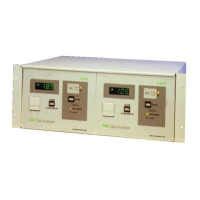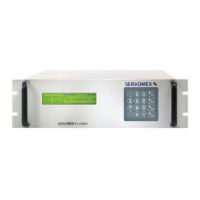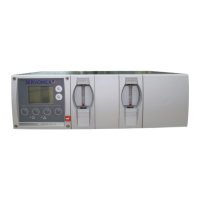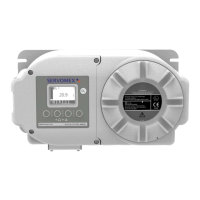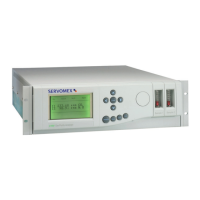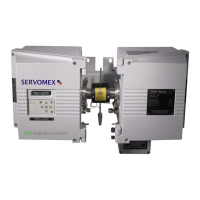3.5
Flow rates with these gases will have to be set at a lower value.
Highest accuracy from the analyser will be achieved if the cell flowrate is kept
constant. Calibration gases should have the same flowrate as the sample gas.
2. With 1162 Wet Gas Sampling System
a. Fill the bubbler bowl with water, using the filling port on the top plate, until it
has reached the level of the drain hole.
b. Close the flow control valve.
c. Check sample pressure is within the range 0.3 to 20 psig (2 to 140kPa).
d. Open the flow control valve and adjust it so that there is a constant stream of
bubbles from the shorter (small diameter) dip leg and a steady stream of
bubbles through the bypass - the longer (large diameter) dip leg.
If the bypass flow is too excessive with violent bubbles then the oxygen reading will be
noisy. Too slow a flowrate will give a long response time.
3.3 SOFTWARE ISSUE NUMBER
The issue of software is identified by a number, eg 1100-681, which is displayed during the self
check routine. These instructions are for 0110066X, 0110067X and 0110068X versions
(where X = 0, 1, 2 or 3). They can also be used for 01100651, 01100652 and 01100699
versions. Where these versions differ is highlighted in the text and summarised in Appendix 7.
3.4 INITIAL START-UP
Fit memory back-up batteries. (Earlier analysers only - see Section 4.5 for details)
Switch on the main electricity supply to the analyser.
Note: The analyser will need switching on twice to eliminate alarm code 67 - memory fail
alarm. Leave a delay between each switch-on to allow the self-check routine to be
performed.
In systems using an Interface unit it is this that will have to be switched on twice.
Allow at least 12 hours for the analyser to warm up before calibrating and making accurate
measurements.
Sample gases with high dew points should not be passed through the analyser until the
transducer has reached operating temperature to prevent the possibility of condensation in the
measuring cell.
